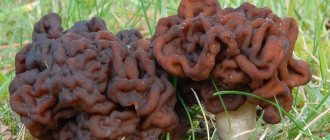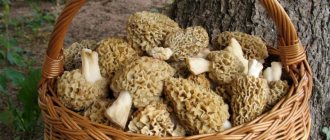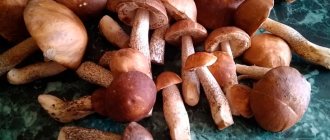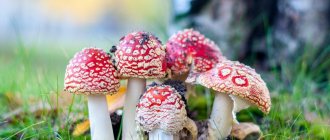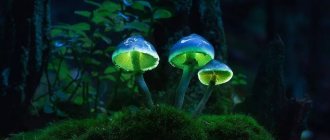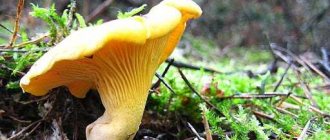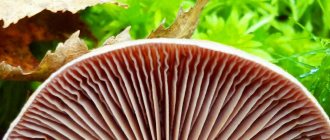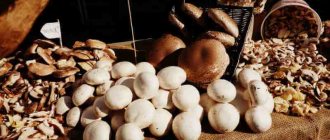First mushrooms of the year
The mushroom picking season in Belarus begins early: already in April-May. The first rays of the gentle spring sun begin to warm, the trunks of birch trees are filled with sap. It is at this time that the first harvest of mushrooms can be harvested. What mushrooms grow in Belarus in early spring? These are morels and lines. When the birch buds swell and turn red, and the aspen earrings fluff up, you can safely look for “snowdrop” mushrooms in the forest. They grow on the slopes of ravines, forest clearings and clearings, old burnt areas and abandoned forest roads. The stitches are brown in color and are soft and velvety to the touch.
Their smell is pleasant. Their shape is squat, the top of the cap is folded. Morels are olive-brown in color and have sharp-shaped caps. Mushrooms of Belarus of the early period have such forms for a reason. The design helps to absorb more heat and the first sunlight.
What mushrooms can be collected in May and early June?
The next mushroom hunting season in the republic falls at the end of May - beginning of June. At this time, the rowan blossoms and the rye begins to spike. There are few mushrooms at this time, but you can find them.
At the beginning of summer, mushrooms in Belarus grow in the lightest places in the forest: edges, clearings, and in young forests where dense vegetation has not yet formed. There is no need to expect a bountiful harvest at this time, since there is not enough heat yet, although there is plenty of moisture in the ground. Mushrooms at the beginning of summer are usually called “scouts”: they crawl out of the ground to check whether it is warm in the forest and whether it is already possible to grow en masse. This time of mushroom growth is short, it lasts about two weeks. What types of mushrooms are relevant in Belarus at this time? Butterflies, russula, fly mushrooms, and porcini mushrooms can also be found.
A few simple rules - how to avoid mushroom poisoning
First. Don't pick unfamiliar mushrooms! These forest creatures are not a subject for experimentation. Take only those mushrooms that you are confident in.
Second. Carefully examine each of your finds. And if you notice something strange that distinguishes the mushroom from the ones you know, don’t take it.
Third. Do not collect overgrown or wormy mushrooms. In the overgrown mushroom, decomposition processes have already begun. And since it consists largely of protein...What happens to any protein product (for example, meat) stored in improper conditions? The same thing - decomposition with the release of toxic substances - occurs in an overripe mushroom. And insect larvae can add their waste products to the overall “bouquet”.
Fourth. Do not pick mushrooms near busy roads, near industrial enterprises and in areas where they emit waste, or near landfills. Such mushrooms usually contain high doses of heavy metal salts, various carcinogens and other harmful substances.
Fifth. Do not use galvanized and glazed ceramic dishes for pickling and marinating mushrooms. Poisoning can be severe!
Sixth. Don't try to can mushrooms! You will not be able to protect yourself at home from the development of botulinum (or butulinus) bacteria – Clostridium botulinum – in such canned food.
These bacteria are ubiquitous, living in soil and water. Under normal conditions, when they enter the human body, they, like their spores, remain safe. But without free access to oxygen (and these are the conditions we will create by “rolling up” the jar), botulinum actively multiplies, releasing poison (botulinum toxin), which causes severe damage to the nervous system.
I would not even recommend sealing jars of salted and pickled mushrooms hermetically! For the same reason. Yes, an acidic environment inhibits the development of botulinum. Only very sour! So sour that you won’t eat mushrooms marinated with so much vinegar - it’s not tasty! And by reducing the amount of vinegar and closing the jar with a metal lid, you risk getting serious food poisoning - botulism.
Seventh. If you buy mushrooms at the market, it is better to do it from well-known, trusted sellers. Mushrooms must be sorted by variety - no assorted mushrooms. And it’s better to buy mushrooms fresh... Be sure to carefully inspect your purchase.
I hope I answered the question - how not to get poisoned by mushrooms?
Please, your questions and comments - in the comments.
I invite you to subscribe to blog updates - click on the picture below.
By clicking on the picture, you consent to the newsletter, the processing of personal data and agree to the privacy policy
If the article is worthy, share it with your friends on social networks.
Best regards, Alexander Silivanov
Read similar articles:
- Spike mushrooms
- White mushroom in the forest
- How to test mushrooms for toxicity?
- Fly agaric red
- Royal fly agaric
What mushrooms are collected during the flowering of rye?
Mid-June is a good time to harvest. During the flowering of rye, boletus mushrooms can be found in the forest. After the lilies of the valley bloom, it is time to collect chanterelles. They are unpretentious: they grow on any soil, in mixed, coniferous and deciduous forests. The main thing is that there is enough moisture in the soil. Also in June, boletuses, pig mushrooms and champignons appear. When the rye fades and the time comes to harvest strawberries, the spikelets appear. They grow along country roads, under birch and oak trees.
In birch forests they grow in whole families. When the first harvest of spikelets leaves, they move from the hot rays of the coming summer to the lowlands. They also grow closer to swamps, hiding in their tall grass and moist soil. After thunderstorms and rains, the time comes for moss mushrooms and colored russula. There are a lot of these mushrooms in the forests; they do not hide and are always visible to the naked eye. Their caps are bright: yellow, green, orange. This is what pleases the eye of a true mushroom picker!
Edible
The official directory of the republic, which describes edible mushrooms, informs that more than 200 varieties grow in the region that can be eaten. The main difference between this group and inedible forest products is that people are allowed to eat them even raw. Good mushrooms include:
- hen;
- bruise;
- oiler;
- boletus;
- chanterelles, etc.
Porcini
This name is well known to mushroom pickers. Most often, boletus mushrooms grow in sunlit meadows, in birch groves, and on secluded edges.
They have a large tubular cap, reaching 15-45 cm in diameter and colored brown. The powerful leg grows up to 35 cm in height, securely holding the massive mushroom body on the surface of the earth.
The peculiarity of boletus is that it does not darken when cut. This dietary mushroom smells pleasant and does not lose its pronounced aroma when cooked, and drying enhances it. Widely used to create many dishes.
Chanterelles
Found in deciduous forests of Belarus. Collection begins in early summer. They grow in large groups, which allows you to collect a large number of tasty mushrooms in one place.
Chanterelles have the following description:
- fruit body is bright red in color;
- matte funnel-shaped (slightly depressed) cap with wavy edges and size from 3 to 12 cm;
- the flesh of the cap is elastic, but the legs are fibrous;
- small leg (4-7 cm).
These mushrooms are easily distinguished from others by their wavy cap. Fans of “quiet hunting” highlight them for their pleasant taste.
Oiler grainy
The favorite habitats of this species are overgrown edges of forest paths and roads. Grows in large groups. From 3 to 30 such groups can grow in one clearing.
The cap is covered with a light brown dense film, which comes off quite easily in young specimens, and becomes slimy in rainy weather. The elastic, fleshy white flesh of young specimens becomes loose in older ones. It has practically no smell. The hymenophore changes from light yellow to a gray-yellow color as the fungus grows.
The granular oiler differs from other species of the genus in the absence of a membranous ring on its white, dense cylindrical stem. As it ages, light yellow drops of moisture appear on the stem, which become dark when dry. It was they who gave the name to the species - granular oiler.
There are specimens with both small (2-3 cm) and large caps (8-10 cm). They prefer calcareous soils and young pine forests. If conditions are good (appropriate humidity level), they appear as early as June.
Boletus
Thanks to its bright colors, it can be easily seen in forest thickets. The orange-red cap of the mushroom is from 5 to 50 cm in diameter. Young boletuses are distinguished by a convex cap shape, which becomes flatter as the mushroom ages.
Large redheads (the popular name for the mushroom) contain practically no useful substances, so they are extremely rarely eaten. Mushroom pickers give preference to young specimens, because They are distinguished by their excellent taste and the quality of the fruiting body itself - the density and elasticity of the pulp. But in old mushrooms it begins to soften and becomes suitable only for feeding worms.
When cut, the stem of the mushroom darkens, acquiring a black-blue hue. Boletus does not have a pronounced odor, but has a pleasant taste. Adult redheads do not exceed 15-16 cm in height.
Ryzhik
Saffron milk caps are universal in use
Many mushroom pickers believe that these mushrooms are in no way inferior to boletus mushrooms. Possessing high taste qualities, saffron milk caps are widely used in cooking: they are used in the preparation of various dishes and preparations for the winter.
Their main habitat is coniferous forests. Fans of “silent hunting” need to look for them in the thickets of moss.
The mushrooms have a pleasant light orange hue. The small leg (in nature there are no specimens larger than 7-8 cm in height) is very fragile. The smooth cap is covered with a sticky coating. These are lamellar varieties. When cut, the mushroom releases orange juice. At the cut site, the flesh of the saffron milk caps changes its original color to greenish.
Russula
Often found on the territory of this republic. These are lamellar mushrooms that grow in height from 10 to 13 cm. Depending on the climatic conditions of the region, the color of their cap varies.
Russulas come in different types (green, yellow, pink). They grow in mixed, oak and deciduous forests, birch groves. This mushroom is widely used in cooking and is prepared by lovers of “silent hunting” in dried form for the winter. Some species can be eaten after daily salting.
Inexperienced mushroom pickers can easily confuse russula with toadstool. To prevent this from happening, you need to carefully sort through the collected specimens. By the way. To more accurately determine whether mushrooms are poisonous or edible, it is better to take your time and collect mushrooms with stems.
Edible mushrooms of Belarus in the second ten days of July
When the hot season of haymaking is left behind, the linden begins to bloom, and the second season of collecting boletus, boletus, aspen and porcini mushrooms comes. The species diversity of mushrooms at this moment is high, but the harvest is small. This is explained by weather conditions. In order for mushrooms to grow en masse in the second ten days of July, a certain air temperature and light rains are necessary. The normal precipitation should not be exceeded. For about two weeks, mushroom pickers can walk through the forest in search of crops, then again there will be a lull. But the last month of summer truly pleases mushroom pickers! This is the golden time of harvest. In August, the largest and most varied harvest of mushrooms awaits quiet hunters. Over the summer, the earth warmed up, the mycelium gained strength and grew. The fogs of August are a clear signal for the beginning of the real harvest season.
Mushroom picking in August is the golden time
Deciduous mushrooms are the third harvest season. Svinushki, aspen boletuses, and boletus mushrooms are found in large quantities in the forests of Belarus. But new species of mushrooms also appear that are not found until August. These are edible mushrooms of Belarus, such as saffron milk caps and volushki. Mushroom pickers are very pleased with such gifts from the forest.
Boletuses are usually the first to appear in August. The white leg and red cap are visible from afar, because these mushrooms do not hide. The red cap is found on a mushroom growing under aspen or in well-moistened soil. If he grew up in a clearing or forest road, his cap will be dark and his leg will be thick. If it appears in a birch forest, where spruce and pine are found, its cap will have a yellow-red tint, and its thick leg will have scales. And finally, an aspen boletus grown in a pine-birch forest with high soil moisture will have a white cap.
Places and rules of collection
There are a great many mushroom places in Belarus. As a rule, experienced lovers of “quiet” hunting include the Minsk and Vitebsk regions as the most mushroom places. Many mushrooms grow in forests along the Vitebsk direction highway , starting from the settlement of Logoisk to the village of Pleschenitsy, near the villages of Molodi, Oleshniki, Mostishche, Krokva, Takovshchina and Pogrebishche . Here you can collect a very good harvest of boletus, boletus, boletus, boletus, honey mushrooms, moss mushrooms, chanterelles and russula.
The Khatyn Forest, which stretches for several kilometers, is also extremely popular among mushroom pickers. In the Stolbtsovshchina, near the “Vysoky Bereg” tourist center, you can collect boletuses, redcaps, chanterelles, boletuses and autumn honey mushrooms almost throughout the entire mushroom season. A large forest area is located near the Economist recreation center near the village of Ilya. When collecting mushrooms, you must follow the rules of “quiet” hunting and process the harvest as quickly as possible.
Where do boletus grow?
Boletuses are the recognized kings of the forest. They can grow in any forest in groups or alone. Mushrooms in the forests of Belarus especially love places where there are blueberries, lingonberries, and fly agaric mushrooms. They love boletus and many anthills. If the boletus grew in a spruce forest, then it is a strong brown mushroom with light spots.
In a pine forest it is different - dark, sometimes the cap even has a purple tint. Mushrooms with a long stem, strong flesh and a light brown cap grow under birch and oak trees. Their leg is longer than that of other boletus mushrooms.
Hallucinogenic
The name speaks for itself. They cause visual hallucinations, temporary mental impairment, disruption of the nervous system, and hearing loss. Mushrooms contain a toxic substance, psilocin, which can provoke the development of schizophrenia with long-term use.
The following hallucinogenic mushrooms are found in the Republic of Belarus:
- Paneolus hay (dung beetle): requires organic matter for active development, therefore it is more often found in mixed forests and freshly loosened fields. It is distinguished by a small brown-red in wet weather and a light brown cap (8-30 mm), shaped like a bell. In dry weather, its surface is covered with small scales. The medium-length gray leg has increased fragility. Paneolus can cause severe damage to the nervous system.
- Paneolus moth (dung beetle): found in pastures, on horse or cow manure, and rotted grass. The cap, 1-4 cm in diameter, is convex in young specimens, and bell-shaped in adults. The color may be gray-brown or dark gray. Along the edges there are triangular scales (small, whitish) - the remains of the bedspread. Over time they disappear. The leg is thin and long. Young mushrooms are gray with a whitish coating, while mature ones are dark brown.
- Mycena pure: grows in the forests of Belarus and other countries. The favorite habitats of this mushroom are bushes. The nutrient medium for it is created by fallen, rotten leaves. It appears at the end of spring. Mushrooms are easily identified by their vibrant purple, yellow and blue colors. The hat resembles a small bell. Its diameter is 2-7 cm. The pulp is white with a pungent alkaline odor.
- Sulfur head: the cap is 2.5-5 cm in diameter. At first it is cone-shaped, then bell-shaped, and in very old specimens it is flat with strongly curved edges. The skin is smooth and, most importantly, durable. In dry weather its surface is yellowish, in wet weather it is chestnut brown and sticky. The flesh of the cap resembles amber in color. At the break it turns bluish. The leg is almost white, amber below, up to 10 cm high. Representatives of the species are found on dead wood in all types of forests.
- Acute fiber: Resembles honey fungus in appearance. The cap is 1-3 cm in diameter, at first pointed-conical, then almost flat, umber-brown with a tubercle in the center. The pulp is white, with an unpleasant odor; it does not change color at the cut site. The stem is thin, up to 4 cm long, with a slight thickening at the base, the color matches the color of the cap.
- Stinking rower: appears in the forests with the arrival of autumn. This hallucinogenic mushroom can grow singly or in large groups. The white cap has brown streaks, its size ranges from 5 to 8 cm. It has a characteristic pungent odor. The dense stem does not differ in color from the cap. Eating rowan grass causes auditory and visual hallucinations.
Candidate of Biological Sciences, mycologist and ethnomycologist Mikhail Vishnevsky writes on his website that for these mushrooms that cause psilocybin syndrome, one of the characteristic signs of the presence of psilocybin in their body, as well as its analogues, is the coloring of the base of the stem in blue.
Therefore, all types of mushrooms whose representatives contain the alkaloid psilocybin in their chemical composition are called “psilocybin mushrooms.”
And just a few years ago it was believed that hallucinogenic mushrooms were not found on the territory of Belarus, but were only imported from the territory of neighboring states.
What to collect in Belarus by the end of August?
Boletus mushrooms appear in the forests of the republic at the end of August. Depending on the place of growth, the appearance of the mushroom also changes. In damp places of the forest, the boletus will have a white leg and a dark gray cap. If mushroom picking in Belarus takes place in dry forests, then the specimens found are usually velvety. If boletus mushrooms are collected in a clearing, the color of their cap will be almost black and the stem will be thick. This boletus even resembles a porcini mushroom. Near swamps and in damp birch forests grows obabok, which has a greenish or white stem. This mushroom is also known as bog boletus. In August, the late boletus, growing in deciduous and coniferous forests, also ripen.
Summer variety
The most popular times of year for mushroom picking are summer and early autumn . Warm, humid weather creates favorable conditions for plant growth and reproduction. At this time, the most popular and valuable types of mushrooms appear, which are highly valued not only in Belarus:
- Borovik. The appearance of the porcini mushroom is known to the vast majority of mushroom pickers; it is considered the most valuable and popular. Young specimens have convex, bulbous caps that become flatter as they grow. The rich brown color of the upper part in combination with a strong white stem gives the mushroom a noble appearance. The pulp is very strong and juicy, white in color and has a characteristic mushroom aroma.
- Boletus. One of the main features of this species is the pulp, which very quickly turns black or blue when cut. A dense and elastic structure is characteristic only of young specimens. The cap is relatively large, colored reddish-orange and has a convex shape. The leg is quite hard, grayish-white.
- Chanterelles. These brightly colored mushrooms can grow in large groups, forming entire glades of yellow or yellow-orange specimens. The cap and the leg merge into a single whole, the upper part has a funnel-shaped shape, and the lower part has a fibrous structure. The pulp is white in color and when cut you can feel a barely noticeable fruity aroma.
What edible mushrooms can be collected in central Russia
It is more arbitrary to classify the listed types of mushrooms as exclusively summer ones, since many of them actively grow in early autumn. Productivity depends on the weather.
Mushroom picking in September
The most beautiful month of the year in the republic is September. Fallen yellow and red leaves, decorating the ground like a fairy-tale carpet, make it difficult for mushroom pickers to find trophies. The mushrooms of Belarus that grow en masse in September are volushki, svinushki, and milk mushrooms. By the way, if the weather is warm, the waves can occur en masse in October, during the Indian summer.
In September, mushrooms again move from the lowlands to high places, because the heat is again insufficient. They appear near clearings, in clearings, roads, and hide in the moss. It takes a very long time to collect scraps in the birch forests, until the last leaves fall from the birch trees. From the second ten days of September, oyster mushrooms appear in the forest. Their collection takes a long time, until October. Most often they can be found on tree stumps. Oyster mushrooms and honey mushrooms can grow until the first snow. Moreover, during the thaw, these mushrooms resume growth, remaining just as tasty.
Poisonous
Poisonous mushrooms differ from inedible ones in that they contain toxic substances that can cause severe poisoning in humans and even cause death, so mushroom pickers need to avoid them.
- Pale toadstool: This is the most dangerous member of the mushroom kingdom. Toadstool not only causes severe poisoning, but is also the cause of death for inexperienced mushroom pickers. Most often, lovers of “silent hunting” mistake this poisonous mushroom for champignon or russula. The pale grebe changes the color of its cap depending on age and growing conditions. So, it turns from pale green to gray and reaches a diameter of 10-15 cm. The leg is quite large - 16-18 cm in height. This dangerous mushroom has no particular taste or smell. Nothing in its appearance raises doubts among mushroom pickers.
- False honey fungus: thanks to its yellowish-orange color, the mushroom is successfully disguised as an edible honey fungus. It does not have the “skirt” under the cap that is characteristic of many poisonous varieties, because it disappears very quickly during the growth of the fungus. The cap of a young false honey fungus looks like a bell. The mushroom smells sharp and unpleasant. Has a bitter taste. It is distinguished by its small size (hat - 5 cm, leg - 6-7 cm). The fruit body is hollow.
- Fly agaric: The bright red cap reaches a fairly large size (up to 20 cm). The mushroom has a stable white stalk that grows up to 10-25 cm in height. False fly agaric mushrooms sometimes do not have white spots. Inexperienced mushroom pickers confuse them with russula and boletus. This variety can be distinguished by the characteristic plates located under the cap. The older the specimen, the brighter its color. In Belarus they grow in birch groves and mixed forests.
When collecting mushrooms, care should be taken not to confuse edible varieties with poisonous ones.
What mushrooms should you not pick?
Unfortunately, poisonous mushrooms also grow in Belarus, just like everywhere else. They contain harmful substances that do not disappear during heat treatment. It is very important to know which mushrooms are inedible, because eating them can cause severe poisoning and even death. Particularly dangerous are mushrooms that are similar to edible ones - their “doubles”:
- The gall mushroom is very similar to the white one. Its second name is false boletus. If you cannot figure out what kind of mushroom is in front of you, cut its cap. If the flesh turns pink before your eyes, the mushroom is inedible.
- Pale toadstool is a lamellar mushroom with a hemispherical hat of light green, olive or slightly gray color. The leg is cylindrical, slightly thicker at the bottom. It happens that mushroom pickers confuse toadstool with champignon. If you see lamellar thickenings on a mushroom, it is poisonous.
- False honey fungus - grows on rotten trunks, stumps and near them. Its main difference from the edible honey mushroom is the color of the plates. The edible mushroom has olive or whitish plates; in the false mushroom they are dark.
- The pepper mushroom is the poisonous counterpart of the butter mushroom. Its cap is brown, rounded and convex. When the weather in the forest is humid or it rains, the hat becomes covered with mucus, which should not happen with a true oiler. The flesh of the mushroom turns red when broken.
- False chanterelle - grows in coniferous forests on stumps and tree trunks. Can grow in families or alone. The plates of the cap are brighter in color than the body. This feature distinguishes a poisonous mushroom from an edible one.
Mushrooms in Belarus today delight “quiet” hunters with their quantity and species diversity. Each mushroom season of the year brings something special and unique. The article describes the order of appearance of mushrooms in the Republic of Belarus from the earliest spring to the first frost. But do not forget that the weather often makes its own adjustments to the mushroom calendar. In cool weather, mushrooms grow more slowly; in warm, but not hot, the harvest is plentiful. And after good rainfall, as the temperature in the forest drops, mushrooms will begin to gravitate towards light and warmth. Remember this when you go for a walk in the forest with a basket in your hands.
Description of spring species
With the onset of warm days, when the soil has warmed up and the air temperature no longer drops below 15 degrees, the mushroom season officially begins.
Morels
These are mushrooms that are considered pioneers, since they are the ones who begin the spring hunting season for forest gifts. Adult specimens often reach significant sizes (up to 25 cm). Among other varieties, they are clearly distinguished by their cap, which is known for its unusual structure. Outwardly, it resembles a honeycomb and has an ovoid, spherical, bell-shaped, conical or ellipsoidal shape, with a plexus of longitudinal and transverse ribs.
The color scheme is varied; you can find specimens with a dirty grayish-white or dark brown cap. The characteristics of pigmentation most often depend on the type of fungus and its age. The leg is cylindrical, white or yellow-brown in color with small pimples scattered over its entire surface. The morel pulp is fragile and thin, has a waxy white color and a pleasant aroma.
Stitches
The external characteristics of the mushrooms are very similar to their morel cousins, but the upper part (the cap) is even more curved and decorated with deep grooves. Its shade can be brown, chestnut or yellow-chestnut. Most often, the shape of the cap can be compared to a walnut.
Their stems are white; sometimes there are specimens with a pink color. The pulp of the strings is light, without any bitter taste or unpleasant aroma. They can be found in deciduous or mixed forests, especially in ravines and roadside ditches.
